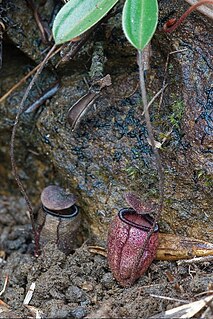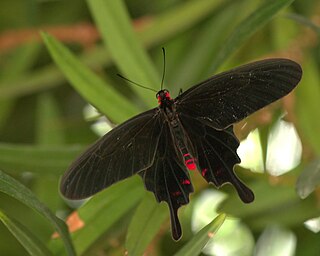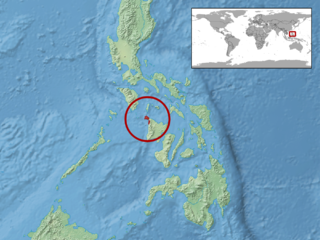
Romblon is an archipelagic province of the Philippines located in the Mimaropa region. Its main islands include Tablas, the largest, which covers nine municipalities, Sibuyan with its three towns, as well as the smaller island municipalities of Corcuera, Banton, Concepcion, San Jose, and Romblon, the provincial capital. The province lies south of Marinduque and Quezon, east of Oriental Mindoro, north of Aklan and Capiz, and west of Masbate. According to the 2015 census, it has a total population of 292,781.

Gekko is a genus of Southeast Asian geckos, commonly known as true geckos or calling geckos, in the family Gekkonidae. Although species such as Gekko gecko are very widespread and common, some species in the same genus have a very small range and are considered rare or endangered. Fossils, including Yantarogekko, date back to the Eocene.

The Sibuyan Sea is a small sea in the Philippines that separates the Visayas from the northern Philippine island of Luzon.

The Visayan Sea is a sea in the Philippines surrounded by the islands of the Visayas: Western Visayas, Eastern Visayas, and Central Visayas to the south. It is bounded by the islands Masbate to the north, Panay to the west, Leyte to the east, and Cebu & Negros to the south.

Sibuyan is a crescent-shaped island, the second largest in an archipelago comprising Romblon Province, Philippines. Located in the namesake Sibuyan Sea, it has an area of 445 square kilometres (172 sq mi). The island has two prominent peaks, Mount Guiting-Guiting with a height of 2,058 metres (6,752 ft) and Mount Nailog with a height of 789 metres (2,589 ft). The people speak the Sibuyanon dialect of Romblomanon, a Visayan language.

Mount Guiting-Guiting is the highest mountain in the province of Romblon located at the heart of Sibuyan Island and dominates the entire island. Guiting-Guiting, in the local Romblomanon dialect, means "jagged". The mountain is one of the focal points of Sibuyan's declaration as a biodiversity haven. The entire island has been compared numerous times with the biodiversity endemism rate of the Galapagos islands. This endemism prompted much of the mountain and its slopes to be protected under the Mt. Guiting-Guiting Natural Park, established in 1996. The park also encompasses nearby Mt. Nailog to the west.

The genus Chrotomys contain a unique group of rodents found only in the Philippines, specifically the islands of Luzon, Mindoro, and Sibuyan. Instead of being predominantly herbivorous or omnivorous like other murines, these rats feed predominantly on invertebrates although they do eat some vegetable matter. This vermivory is probably the result of a rat-like animal moving into an ecological niche usually filled by shrews. Shrews and other insectivores are absent on these Philippine islands.

Nepenthes sibuyanensis is a tropical pitcher plant endemic to Sibuyan Island in the Philippines, after which it is named.

Nepenthes argentii is a highland Nepenthes pitcher plant native to Mount Guiting-Guiting on Sibuyan Island in the Philippines. It is possibly the smallest species in the genus and does not appear to have a climbing stage.

Nepenthes graciliflora is a tropical pitcher plant endemic to the Philippines. Long considered a synonym of N. alata, it was restored as a separate species in 2013 by Martin Cheek and Matthew Jebb. It has been recorded from the islands of Bohol, Leyte, Luzon, Mindanao, Mindoro, Panay, Samar, and Sibuyan, and following the redelimitation of N. alata is the most widespread Nepenthes species of the Philippines. It is known from mossy, submontane forest, generally at 800–1,280 metres (3,000–4,000 ft) altitude, though the type specimen from Sibuyan was collected at only 300 m (1,000 ft).

The Philippine warty pig is one of four known species in the pig genus (Sus) endemic to the Philippines. The other three endemic species are the Visayan warty pig, Mindoro warty pig and the Palawan bearded pig, also being rare members of the family Suidae. Philippine warty pigs have two pairs of warts, with a tuft of hair extending outwards from the warts closest to the jaw. It has multiple native common names, but it is most widely known as baboy damo in Tagalog.

The pygmy forest frog is a species of frog in the family Ceratobatrachidae. It is endemic to the Philippines. It occurs in the Central Cordilleras and Sierra Madres of northern Luzon, and possibly also on Sibuyan Island.

The Philippine tube-nosed fruit bat locally known in Tagalog as Bayakan is a species of bat in the family Pteropodidae. It is endemic to the Philippines and known from the islands of Cebu, Negros and Sibuyan. It occurs in and near primary and secondary subtropical or tropical dry forests. It is often found near water. It is threatened by habitat loss due to deforestation. The species is named for Dioscoro S. Rabor who, with several others, first collected the species.

Asota egens is a species of noctuoid moths in the family Erebidae. It is found from Japan and the Oriental tropics, east to New Guinea.

Pachliopta kotzebuea, the pink rose, is a butterfly of the family Papilionidae. It is found in the Philippines.
The Sibuyan shrew is a species of shrew from the Philippines.
Nepenthes armin is a tropical pitcher plant native to the Philippines. The type specimen was collected in 1989 on Sibuyan Island, at an elevation of 750 m above sea level. The specific epithet armin honours Armin Rios Marin.

Gekko ernstkelleri is a species of gecko, a lizard in the family Gekkonidae. The species is endemic to the Philippines.

Gekko monarchus, also called the spotted house gecko, is a species of gecko found in the Malay Peninsula, some smaller Malaysian islands, Borneo, the Philippines, many Indonesian islands including Sumatra, Java, Sulawesi, and New Guinea.
Ross's Calayan gecko is a species of lizard in the family Gekkonidae. The species is endemic to Calayan Island in the Philippines.















